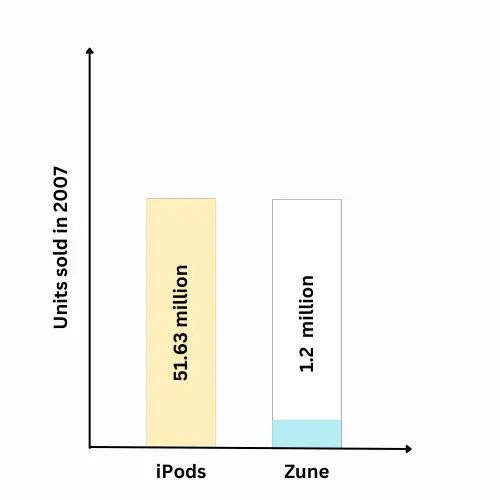Microsoft Corporation is a successful multinational technology company based in Washington, D.C. Microsoft’s most well-known software products include the Windows operating system, the Microsoft Office suite, the Internet Explorer, and Edge web browsers.
And unless you’ve been living under a rock, you must have used one of the products that Microsoft offers.
But there is a Microsoft software that couldn’t join the list of Microsoft innovations–Zune.
Zune is a discontinued media management software application for Microsoft Windows that served as a complete media player application with a library, an interface to the Zune Marketplace, and a media streaming server.
It was launched as a competitor to the extremely popular Apple iPod in late 2006. But only six years later, in 2011, Microsoft ceased production of the Zune 30 and the Zune Marketplace, products that were flawed from the beginning.
GIPHY: Microsoft Zune Failure
Why did Microsoft Zune fail?
Microsoft Zune failure was the result of the following:
An Unhealthy Assumption
Microsoft began by assuming that there was a market for the product they were developing: a direct competitor to the iPod in terms of functionality and pricing.
Looking back, it is clear that this was a mistake since Zune failed to acquire even 10% of the mp3 market share while the iPod dominated. For only $10 less than the iPod, users had little reason to choose the Zune over the market-leading iPod.
Furthermore, Microsoft thought that in 2006, five years after the launching of the iPod, they would be able to create direct competition.
By this point, Apple had absorbed so much of the market and established itself as the industry standard.

This put the Zune at an early disadvantage.
Strategic Shift
Adding to the bad timing of the device release, Apple’s strategic shift to release the first-generation iPhone and the iPod Touch a year after the Zune bore a heavy cost to Zune.
Apple ushered in t he smartphone era, and users suddenly had smartphones with built-in MP3 players. User demand for any standalone mp3 device declined.
So when Microsoft’s focus shifted to stay parallel with Apple by focusing on the development of the Windows Phone platform, it contributed to Zune’s early demise.
No Innovation at all
Despite being one of the IT industry leaders, Microsoft failed to innovate in its media management product.
Regarding features, Microsoft released a carbon copy of the iPod and failed to innovate and solve any genuine problems of the consumers.
While the Zune had some unique features, such as wireless music sharing between devices, these features weren’t compelling enough to draw significant interest away from the iPod.
Tony Scherba, President of the design studio Yeti LLC, mentioned that it was clear Microsoft did not do enough research or prototyping. He went on to state, “If it had, Microsoft would have learned prior to release that consumers didn’t truly value Zune’s features. The company assumed they did, and that was its downfall.”
Lack of New Ideas for Marketing and Branding
“We did some really artsy ads that appealed to a very small segment of the music space, and we didn’t captivate the broad segment of music listeners,” said Robbie Bach, former leader of Microsoft’s mobile sector, to Business Insider.
The Zune’s marketing campaign, which included slogans like “Welcome to the social” and shared “Zune Cards,” didn’t resonate well with consumers like Apple’s iconic advertising and branding.
Geographical Limitations
Microsoft Zune was limited to a few markets, particularly in the United States. It naturally meant that it was not available for a broader user base, which restricted the global expansion of the product.
On the other hand, iPod was breaking geographical barriers. And Apple’s marketing efforts were creating a demand for the product across the globe.
But here’s a twist: Zune Saved Microsoft
Yep! You read that right.
The product failed so miserably that it accounted for only 2 percent of the music-player market before it was discontinued.
But the Microsoft Zune failure ended up being the reason that helped the company understand the value of business innovation.
Microsoft mended its ways and started working on innovative hardware and software, leveraging its top talent. It was no longer chasing a product that could be a direct competitor to iPod.
Related Read: Benefits of an Intrapreneurship Culture
Microsoft adopted the innovation strategy of creating its own innovation strategy and being a trendsetter.



